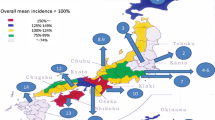Abstract
Background
Liver-type fatty acid-binding protein (L-FABP) in urine is one of the early diagnostic biomarkers for acute and chronic kidney injuries. Although this protein is also identified in the intestine, there is no verified reference value for patients with intestinal urinary diversion (UD). The aim of the present study was to measure L-FABP values in such patients and compare them with the results for patients without UD.
Methods
Spot urine specimens were collected from 41 patients with UD and 50 subjects without UD with estimated glomerular filtration rates of over 60 ml/min/1.73 m2, and the L-FABP values were measured. The normal upper cutoff value in healthy subjects without UD is considered to be 7.24 μg/g Cr. First, the median values of the two groups were compared. Next, the subjects with negative proteinuria and without comorbidities associated with renal function were further selected and the median values of the groups were compared.
Results
The mean age was significantly higher in the UD group. The types of UD were ileal conduit (38 patients) and ileal neobladder (three patients). The median L-FABP value in the UD group was significantly higher than that in the non-diversion group (89.1 μg/g Cr vs. 2.0 μg/g Cr, p < 0.0001). After adjustment for their backgrounds, the median value remained higher in the UD group.
Conclusions
L-FABP values in subjects with UD are higher than in those without UD. By this result, to develop a reference value in patients with intestinal UD population, further studies are required.




Similar content being viewed by others
References
Devarajan P. Biomarkers for the early detection of acute kidney injury. Curr Opin Pediatr. 2011;23:194–200.
Xu Y, Xie Y, Shao X, et al. L-FABP: a novel biomarker of kidney disease. Clin Chim Acta. 2015;445:85–90.
Noiri E, Doi K, Negishi K, et al. Urinary fatty acid-binding protein 1: an early predictive biomarker of kidney injury. Am J Physiol Renal Physiol. 2009;296:F669–79.
Kamijo A, Sugaya T, Hikawa A, et al. Urinary liver-type fatty acid binding protein as a useful biomarker in chronic kidney disease. Mol Cell Biochem. 2006;284:175–82.
Matsui K, Kamijo-Ikemori A, Hara M, et al. Clinical significance of tubular and podocyte biomarkers in acute kidney injury. Clin Exp Nephrol. 2011;15:220–5.
Smathers RL, Petersen DR. The human fatty acid-binding protein family: evolutionary divergences and functions. Hum Genomics. 2011;5:170–91.
Ikehata Y, Tanaka T, Ichihara K, et al. Incidence and risk factors for acute kidney injury after radical cystectomy. Int J Urol. 2016;23:558–63.
Hatakeyama S, Koie T, Narita T, et al. Renal function outcomes and risk factors for stage 3B chronic kidney disease after urinary diversion in patients with muscle invasive bladder cancer. PLoS ONE. 2016;11:e0149544.
Hirobe M, Tanaka T, Shindo T, et al. Complications within 90 days after radical cystectomy for bladder cancer: results of a multicenter prospective study in Japan. Int J Clin Oncol. 2018;23:734–41.
Matsuo S, Imai E, Horio M, et al. Revised equations for estimated GFR from serum creatinine in Japan. Am J Kidney Dis. 2009;53:982–92.
Kanda Y. Investigation of the freely available easy-to-use software “EZR” for medical statistics. Bone Marrow Transplant. 2013;48:452–8.
Lawrentschuk N, Colombo R, Hakenberg OW, et al. Prevention and management of complications following radical cystectomy for bladder cancer. Eur Urol. 2010;57:983–1001.
Weiner DE, Tighiouart H, Amin MG, et al. Chronic kidney disease as a risk factor for cardiovascular disease and all-cause mortality: a pooled analysis of community-based studies. J Am Soc Nephrol. 2004;15:1307–15.
Yang WJ, Cho KS, Rha KH, et al. Long-term effects of ileal conduit urinary diversion on upper urinary tract in bladder cancer. Urology. 2006;68:324–7.
Osawa T, Shinohara N, Maruyama S, et al. Long-term renal function outcomes in bladder cancer after radical cystectomy. Urol J. 2013;10:784–9.
Yamamoto T, Noiri E, Ono Y, et al. Renal L-type fatty acid-binding protein in acute ischemic injury. J Am Soc Nephrol. 2007;18:2894–902.
Rinnab L, Straub M, Hautmann RE, et al. Postoperative resorptive and excretory capacity of the ileal neobladder. BJU Int. 2005;95:1289–92.
Matsuki M, Tanaka T, Maehana T, et al. Serum cystatin C can be used as a marker of renal function even in patients with intestinal urinary diversion. Asian J Urol. 2015;2:167–9.
Yamada S, Umemori Y, Takahashi Y, et al. A performance evaluation of urinary L-form fatty acid-binding protein measurement reagent “norDeer L-FABP” and examination of the specimen stability. JJCLA. 2018;43:252–9 ((in Japanese)).
Acknowledgements
The authors thank Mr. Kim Barrymore for the correction of English in this manuscript.
Author information
Authors and Affiliations
Corresponding author
Ethics declarations
Conflicts of interest
The authors have declared that no conflict of interest exists.
Ethical approval
All procedures performed in studies involving human participants were in accordance with the ethical standards of the institutional research committee at which the studies were conducted (approval no. 272-96) and with the 1964 Helsinki declaration and its later amendments or comparable ethical standards.
Informed consent
Since this was an observational, but not prospective, intervention study, the Ethics Committee provided a waiver of written informed consent. We announced the commencement of this study on our website (http://web.sapmed.ac.jp/la/) with the proviso that the patients who participated in this study could withdraw later.
Additional information
Publisher's Note
Springer Nature remains neutral with regard to jurisdictional claims in published maps and institutional affiliations.
About this article
Cite this article
Maehana, T., Ichihara, K., Takahashi, S. et al. Significance of urinary liver-type fatty acid-binding protein in patients with normal renal function after undergoing intestinal urinary diversion: a preliminary study. Clin Exp Nephrol 25, 1151–1157 (2021). https://doi.org/10.1007/s10157-021-02088-7
Received:
Accepted:
Published:
Issue Date:
DOI: https://doi.org/10.1007/s10157-021-02088-7




